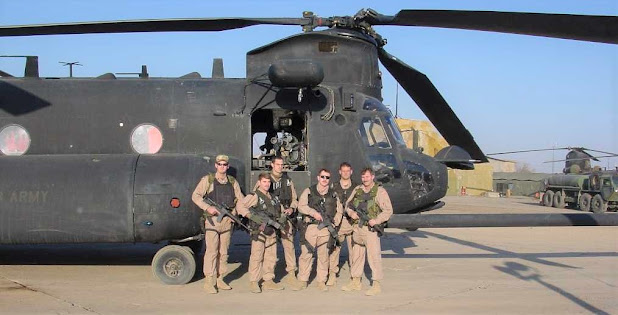America's Response 2001
On this night nineteen years ago,
one MH-47E and two MH-60 DAPS departed Task Force Dagger’s staging base at K-2
airbase, Uzbekistan. The secret mission was a key piece in America’s response
to the horrific attacks of 9/11. The three helicopters were saddled with delivering
Special Forces ODA 595, a team that would gain the moniker, Horse Soldiers.
I was the flight leader of this
momentous mission. After crossing the first mountain range, nicknamed ‘the bear,’
our three fuel-thirsty helicopters descended into a narrow valley to rendezvous
with an MC-130P tanker to extend our range. This vital jet fuel would get us
deep into Afghanistan to deliver our precious cargo, ODA 595, but would not be
enough to make it home without another refueling track. The weather was clear
and cold. The dark sky revealed stars I’d never seen, and my favorite
constellation Orion.
The temperature would only drop as
we ascended the elevations in Afghanistan. The gorgeous sky and twenty miles of
visibility were supposed to hold up throughout the mission timeframe. That
forecast was based on a computer model built on years of faulty Soviet
meteorology data. Favorable weather did not last as we crossed the Amu Daria
river into the rolling dunes of Afghanistan.
Within minutes of crossing the
border, the video displayed in my Night Vision Goggles turned grainy and dim. I
fumbled with the eyepiece focus rings, but there was no improvement. The radar
showed no precipitation, but something was causing a visual impediment. Sparks
flew from the probe tip, Saint Elmo’s Fire. We’d need static electricity for
that. I quick flick of the Infrared searchlight switch yielded the answer; A
sandstorm, denser than any I’d ever experienced, engulfed our flight.
This was the same type of unforecast
storm that thwarted the helicopters in the Iranian Hostage crisis that led to
mission failure at ‘Desert One.’ Years of training, lessons learned, and
equipment upgrades were about to pay dividends. I looked across the cockpit at
my copilot. His eyes glowed with the green illumination of his NVGs. Without a word,
I selected a Radar mode that would allow us to continue through the approaching
mountains.
“I’ve selected TF with Clearance
Altitude three hundred feet — Follow your cue.”
My copilot moved the controls as
necessary to satisfy the flight director cues. The Chinook climbed and descended
along with the rise and fall of the terrain ahead. Our attack helicopter escorts
didn’t have the benefit of the multi-mode radar and tucked in tight. They were
using me as their obstacle clearance, but it would only work if they could maintain
sight of my aircraft. And I was disappearing in the thick dust cloud. The
Blackhawk crews had guts. But bravery alone wouldn’t keep them alive if they
ran into a mountain.
They didn’t last much longer – they
needed to abort.
There was no way the Commander was
going to let us drive on ‘single ship.’ It sounds cool for a book or movie, but
in reality, with no assets overhead, and no mutual rotary-wing support, I
expected to abort... not this time. The Commander asked for my opinion. “Al,
what do you think?” The answer was ready at the tip of my tongue.
“Sir, we’ll just TF the entire
route.”
“Okay. Go ahead,” he said.
He needn’t say more. The route
continued to our destination with only a few minor events to raise the blood
pressure. As my copilot acknowledged, with a George Clooney movie line, “We
were in a tight spot.”
Our mission, referenced in Doug
Stanton’s movie Twelve Strong, was about to reach its stated goal. We had one
last ridgeline to cross before the Helicopter Landing Zone (HLZ) and we were
still in the clouds and dust. The radar was great, but we still needed to see
out the windows to identify the proper location to land.
I selected a lower radar altitude.
That might help us descend below the obscurations. Yes, there it was. The
landing area was just off the nose. We still had two problems to deal with. We
had a lot of elevation to lose, which wasn’t too hard. But the other issue was
a big one. An enemy ZPU-23-2 was eight hundred meters away from the HLZ. Only a
small hill stood between us. If the enemy had even a few seconds of line-of-sight,
the deadly 23 MM rounds would rip through my thin-skinned aircraft. Staying
masked while making the several thousand-foot drop was a challenge. But I’m
writing this, so we must have survived.
Our ‘precious cargo’ linked up with
the Northern Alliance forces. We retraced our steps, air refueled for a second time,
and landed safely back at K-2. Mission Complete. America’s unconventional
warfare response had begun. Now all these years later, I raise a glass to the
men I carried, the men I flew with, and the support personnel that made it
happen. And who can forget the families that sacrificed their loved ones in the
effort to bring Al Qaeda and the Taliban down.
Night Stalkers Don’t Quit!


First I want to thank you for your service.
ReplyDeleteWe don't often get to hear the first hand account from the unsung heroes such as yourself. Helicopter pilots have to be some of the bravest individuals in the military. Reading your story here makes me appreciate what you and your brothers and sisters do every day even more. Thank you sir for sharing this with us.